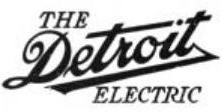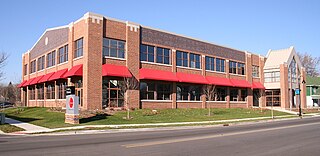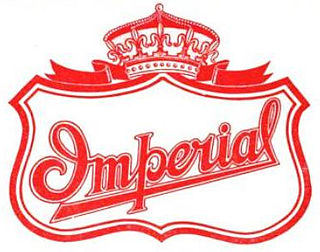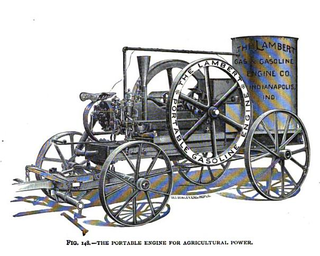Related Research Articles
Anderson may refer to:

The McLaughlin Motor Car Company Limited was a Canadian manufacturer of automobiles headquartered in Oshawa, Ontario. It became General Motors of Canada.

The Winton Motor Carriage Company was a pioneer United States automobile manufacturer based in Cleveland, Ohio. Winton was one of the first American companies to sell a motor car. In 1912 Winton became one of the first American manufacturers of diesel engines.

The Detroit Electric is a modern all-electric car brand by Detroit Electric Holding Ltd. of the Netherlands, from 2008.

The Brass Era is an American term for the early period of automotive manufacturing, named for the prominent brass fittings used during this time for such things as lights and radiators. It is generally considered to encompass 1896 through 1915, a time when these vehicles were often referred to as horseless carriages.

Auburn was a brand name of American automobiles produced from 1900 through 1937.

The Studebaker National Museum is a museum in South Bend, Indiana, United States that displays a variety of automobiles, wagons, carriages, and military vehicles related to the Studebaker Corporation and other aspects of American history.

McFarlan was an American automobile manufactured in Connersville, Indiana, from 1909 to 1928 as an outgrowth of the McFarlan Carriage Company founded in 1856 by English-born John B. McFarlan (1822-1909).
The Tincher was a brand of automobile produced from 1903–1908 in Chicago, Illinois, and from 1908-1909 in South Bend, Indiana. The car was named after its developer, Thomas Luther Tincher, but built by the Chicago Coach and Carriage Company using components and body sections fabricated by the German Krupp steelworks.

John William Lambert was an American automotive pioneer, inventor, automobile manufacturer, and the inventor of the first American gasoline automobile.

The Union automobile was based on Lambert's "horseless carriage" gasoline buggy. It had four wheels instead of his 1891 three-wheeled version. The automobile was made by the Union Automobile Company from 1902 through 1905. There were about three hundred Union automobiles made all total.

The Lambert Automobile Company was a 300,000-square-foot (28,000 m2) automobile factory in Anderson, Indiana to make the Lambert automobile through the Buckeye Manufacturing Company.
Nyberg was the name of an early American automobile manufacturing company, now defunct. Henry Nyberg of Chicago, Illinois, saw an opportunity in the nascent auto industry and purchased the Rider-Lewis Motor Company of Anderson, Indiana, in 1910. The Nyberg company enlarged operations when it began assembling automobiles. As with most automobiles of the time, manufacture of the Nyberg was very labor-intensive. The cars were made by hand and the Nyberg employees took great pride in their output. The company turned out their first finished car on March 30, 1911. Operations ceased in 1914. The company was sold to A. C. Barley of Streator, Illinois.

The Imperial Automobile Company of Jackson, Michigan, was formed by the brothers T.A. and George N. Campbell in 1908, who also ran the Jackson Carriage Company. Imperial produced mid-size cars with four-cylinder engines; the bodywork and mechanicals were primarily off-the-shelf rather than bespoke. Coachwork was done out-of-house by Beaudette Company, which also did work for Buick and Ford. Car production lasted until 1916.

The Buckeye Manufacturing Company was a company originally formed to manufacture horse and buggy parts. It was started in the later part of the nineteenth century and by the early part of the twentieth century was making parts and materials for the Buckeye gasoline buggy automobile as well as for the Union automobile and the Lambert automobile. The company was organized in 1884 in Union City, Ohio, originally under the name of Lambert Brothers and Company. One of the subsidiaries was the Pioneer Pole and Shaft Company, which was run by George A. Lambert, the son of John W. Lambert. Other subsidiaries were the Union Automobile Company, Lambert Automobile Company, and the Lambert Gas and Gasoline Engine Company—run by John W. Lambert.

The Buckeye gasoline buggy or Lambert gasoline buggy was the first practical gasoline automobile available for sale in America, according to automobile historians.

The Union Automobile Company began to make automobiles in Union City, Indiana in 1902. It built the Union automobile from 1902 through 1905. The company was located in Union City, Indiana from 1902 to 1905. In 1905 it moved to Anderson, Indiana.

The Lambert Gas and Gasoline Engine Company was a company founded by John William Lambert in the later part of the nineteenth century as part of the conglomerate of the Buckeye Manufacturing Company.
Charles H. Black was an American carriage maker and automobile pioneer whose business was in Indianapolis, Indiana.
The Halladay Motor Car company was founded in 1905 in Streator, Illinois, and moved to Ohio in 1917.
References
- ↑ Cruise-IN.com - Indiana built automobiles sorted by name Archived 2012-02-07 at the Wayback Machine